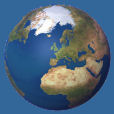We finally got to go to Ciudad Perdida.
A four wheel drive drove us to a small village in the jungle. While
walking out of the village to the beginning of the track we saw this odd looking
chicken.

These are some of the people in our group after maybe 2 hours of
walking. We were already soaked through with sweat - it literally dripped
off us.

The scenery was pretty stunning.

A farmer decided that this tree was dangerous and could fall on some
one. So he took the safest option and decided to burn it.

This was our first camp site (also the location of a coke factory!).

A spider on one of the rocks in the river. They can walk on water -
very cool.

Our hammocks on the first night.

The next morning we visited the coke factory. It is pretty much
just for foreign tourists. The Colombians in our group didn´t come with us
- either they knew it all as they had seen it all before or they weren´t
interested.


After the coke factory we began the trekking. We came across a village
which looked like it was abandoned until we met some of the indigenous
inhabitants.



A toad we spotted along the way.

Some scenery and the river we swam in on our second day.


Our hammocks in the camp we stayed at on the 2nd and 4th nights.

On the third day we had to cross the river many times. This was the
first and most comfortable river crossing - we didn´t have to get our feet
wet!

Us and some indigenous children who were happy to have their photo taken with
us but steadfastly refused to speak to us. The flies buzzing around them
were a sight to behold. The indigenous people only change their clothes
once a month in sync with the moon.

There were many beautiful waterfalls (cascadas in Spanish). Here is
just one of them.

The beginning of the 1200 odd steps which lead up to Ciudad Perdida.

The bottom levels of the lost city.



This view gives some idea of why the city lay hidden for so long. It
was not discovered until the 70s.

The bottom of the main platform.

Me on the main platform. Taken by a kind tourist while Regan was still
in bed.

The lower echelons. These houses are not inhabited but are just to show
what they would have looked like. The men and women live in different
houses (even after marriage). The womens` house has one entrance and the
mens` has two.


Our accommodation on the 3rd night in Ciudad Perdida. Hammocks
again.

A self-portrait shot of the main plaza.

Scenery.

A map of the city.

Stairs in Ciudad Perdida.


The king`s throne.


A piggie we met on the trail home.

 Erin & Regan's South American Adventure
Erin & Regan's South American Adventure


























































































sue: looks good to me. What price the avocado? (02/12/07)
ross: hey anyplace with that much weird candy cant be all bad to live... surely? (02/08/07)
Regan Heath: The avocado was... 4,000 pesos I think. Approx NZ$2.66. (02/19/07)
Chris: Wow the pictures are great. I'm sure having been to the places are even better. Seeing the lost city! Where else have You traveled? I hope to travel as well as you do someday.Best of luck on your future travels (08/30/08)